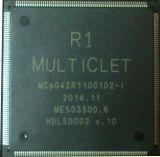This article needs to be updated.(June 2022) |
 Processor R1 | |
| General information | |
|---|---|
| Launched | 2014 |
| Marketed by | MultiClet Corp., [1] resident of Skolkovo [2] |
| Designed by | Digital Solutions [3] |
| Performance | |
| Max. CPU clock rate | 80 MHz to 120 MHz [4] |
| Architecture and classification | |
| Instruction set | Multicellular |
| Physical specifications | |
| Cores |
|
MultiClet is an ongoing innovation project for a microprocessor that became the first post von Neumann, multicellular microprocessor, breaking the paradigm for computing technology that has been in place for more than 60 years. [5] [6] There have been attempts in the past to shift away from the von Neumann architecture. [7] Under MultiClet, a 4-cellular dynamically reconfigurable microprocessor is implemented. [8]